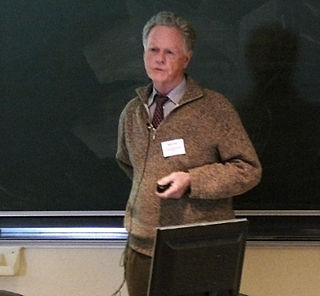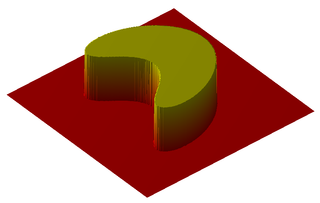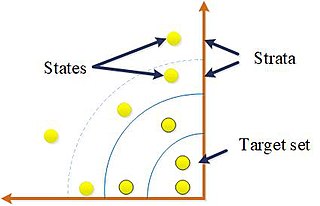Related Research Articles
In fuzzy mathematics, fuzzy logic is a form of many-valued logic in which the truth values of variables may be any real number between 0 and 1 both inclusive. It is employed to handle the concept of partial truth, where the truth value may range between completely true and completely false. By contrast, in Boolean logic, the truth values of variables may only be the integer values 0 or 1.

Lotfi Aliasker Zadeh was a mathematician, computer scientist, electrical engineer, artificial intelligence researcher and professor emeritus of computer science at the University of California, Berkeley.

The theory of belief functions, also referred to as evidence theory or Dempster–Shafer theory (DST), is a general framework for reasoning with uncertainty, with understood connections to other frameworks such as probability, possibility and imprecise probability theories. First introduced by Arthur P. Dempster in the context of statistical inference, the theory was later developed by Glenn Shafer into a general framework for modeling epistemic uncertainty—a mathematical theory of evidence. The theory allows one to combine evidence from different sources and arrive at a degree of belief that takes into account all the available evidence.

In mathematics, an indicator function or a characteristic function is a function defined on a set X that indicates membership of an element in a subset A of X, having the value 1 for all elements of A and the value 0 for all elements of X not in A. It is usually denoted by a symbol 1 or I, sometimes in boldface or blackboard boldface, with a subscript specifying the subset.
In classical logic, propositions are typically unambiguously considered as being true or false. For instance, the proposition one is both equal and not equal to itself is regarded as simply false, being contrary to the Law of Noncontradiction; while the proposition one is equal to one is regarded as simply true, by the Law of Identity. However, some mathematicians, computer scientists, and philosophers have been attracted to the idea that a proposition might be more or less true, rather than wholly true or wholly false. Consider My coffee is hot.
Possibility theory is a mathematical theory for dealing with certain types of uncertainty and is an alternative to probability theory. It uses measures of possibility and necessity between 0 and 1, ranging from impossible to possible and unnecessary to necessary, respectively. Professor Lotfi Zadeh first introduced possibility theory in 1978 as an extension of his theory of fuzzy sets and fuzzy logic. Didier Dubois and Henri Prade further contributed to its development. Earlier in the 1950s, economist G. L. S. Shackle proposed the min/max algebra to describe degrees of potential surprise.

Joseph Amadee Goguen was an American computer scientist. He was professor of Computer Science at the University of California and University of Oxford and held research positions at IBM and SRI International.
A fuzzy concept is a concept of which the boundaries of application can vary considerably according to context or conditions, instead of being fixed once and for all. This means the concept is vague in some way, lacking a fixed, precise meaning, without however being unclear or meaningless altogether. It has a definite meaning, which can be made more precise only through further elaboration and specification - including a closer definition of the context in which the concept is used. The study of the characteristics of fuzzy concepts and fuzzy language is called fuzzy semantics. The inverse of a "fuzzy concept" is a "crisp concept".
Kazem Sadegh-Zadeh is an analytic philosopher of medicine. He was the first ever professor of philosophy of medicine at a German university and has made significant contributions to the philosophy, methodology, and logic of medicine since 1970.
Fuzzy subalgebras theory is a chapter of fuzzy set theory. It is obtained from an interpretation in a multi-valued logic of axioms usually expressing the notion of subalgebra of a given algebraic structure.

George Jiří Klir was a Czech-American computer scientist and professor of systems sciences at Binghamton University in Binghamton, New York.
Fuzzy mathematics forms a branch of mathematics including fuzzy set theory and fuzzy logic. It started in 1965 after the publication of Lotfi Asker Zadeh's seminal work Fuzzy sets.
Type-2 fuzzy sets and systems generalize standard Type-1 fuzzy sets and systems so that more uncertainty can be handled. From the very beginning of fuzzy sets, criticism was made about the fact that the membership function of a type-1 fuzzy set has no uncertainty associated with it, something that seems to contradict the word fuzzy, since that word has the connotation of much uncertainty. So, what does one do when there is uncertainty about the value of the membership function? The answer to this question was provided in 1975 by the inventor of fuzzy sets, Lotfi A. Zadeh, when he proposed more sophisticated kinds of fuzzy sets, the first of which he called a "type-2 fuzzy set". A type-2 fuzzy set lets us incorporate uncertainty about the membership function into fuzzy set theory, and is a way to address the above criticism of type-1 fuzzy sets head-on. And, if there is no uncertainty, then a type-2 fuzzy set reduces to a type-1 fuzzy set, which is analogous to probability reducing to determinism when unpredictability vanishes.
NetWeaver Developer is a knowledgebase development system. This article
- gives a brief history of the system,
- summarizes key features of the software,
- is a bit of a primer, describing basic attributes of a NetWeaver knowledgebase, and
- provides secondary references that independently document some of the NetWeaver applications developed since the late 1980s.
Perceptual computing is an application of Zadeh's theory of computing with words on the field of assisting people to make subjective judgments.
Fuzzy classification is the process of grouping elements into a fuzzy set whose membership function is defined by the truth value of a fuzzy propositional function.
This glossary of artificial intelligence is a list of definitions of terms and concepts relevant to the study of artificial intelligence, its sub-disciplines, and related fields. Related glossaries include Glossary of computer science, Glossary of robotics, and Glossary of machine vision.
Cognitive city is a term which expands the concept of the smart city with the aspect of cognition or refers to a virtual environment where goal-driven communities gather to share knowledge. A physical cognitive city differs from conventional cities and smart cities in the fact that it is steadily learning through constant interaction with its citizens through advanced information and communications technologies (ICT) based ICT standards like IFGICT & ITU and that, based on this exchange of information, it becomes continuously more efficient, more sustainable and more resilient. A virtual cognitive city differs from social media platforms and project management platforms in that shared data is critical for the group's performance, and the community consists of members spanning diverse expertise, backgrounds, motivations, and geographies but with a common desire to solve large problems. The virtual cognitive city is steadily learning through constant metadata generated by activity in the user community.
In logic, an infinite-valued logic is a many-valued logic in which truth values comprise a continuous range. Traditionally, in Aristotle's logic, logic other than bivalent logic was abnormal, as the law of the excluded middle precluded more than two possible values for any proposition. Modern three-valued logic allows for an additional possible truth value and is an example of finite-valued logic in which truth values are discrete, rather than continuous. Infinite-valued logic comprises continuous fuzzy logic, though fuzzy logic in some of its forms can further encompass finite-valued logic. For example, finite-valued logic can be applied in Boolean-valued modeling, description logics, and defuzzification of fuzzy logic.

Concept of Stratification, labelled CST by Prof Lotfi A. Zadeh, was proposed in 2016. Zadeh states that it is a reform in conventional problem solving methods by the consideration of a recursive problem solving approach. Note that this concept should not be mistaken with other similar concepts such as social stratification. CST is not based on social stratification nor related to it. More particularly it is quite different from the previous versions and applications of stratification, such as stratified logic, stratified approach, stratified programming, stratified analysis, among other versions of stratification prior to 2016. This version of stratification can handle a range of problems as explained a year after the original proposal by Asadabadi and his colleagues.
References
- L. A. Zadeh, “Fuzzy logic = computing with words,” IEEE Trans. on Fuzzy Systems, vol. 4, pp. 103-111, 1996.
| This computer science article is a stub. You can help Wikipedia by expanding it. |